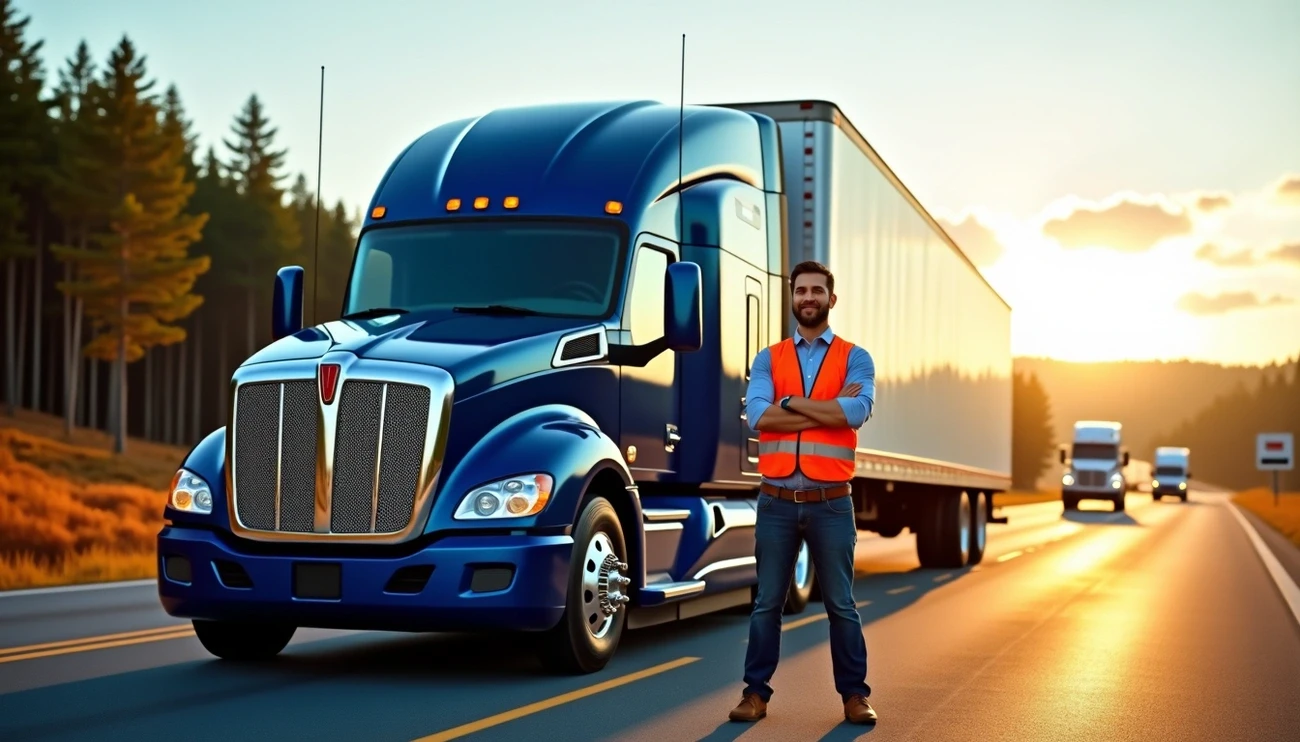If you’re considering a career in commercial driving, one of the first decisions you’ll face is choosing CDL A vs. CDL B License . At Northeast Technical Institute (NTI) in Maine, we’ve been guiding students toward successful trucking careers for 30 years, offering top-tier training for both CDL A and CDL B licenses. Whether you dream of hauling freight across the country or prefer sticking closer to home with local deliveries, understanding the differences between these two licenses—and the training involved—is key to steering your career in the right direction.
In this blog, we’ll break down the distinctions between CDL A and CDL B licenses, explore how NTI structures its training programs to prepare you for each, and share real insights from students who’ve walked the path before you. Let’s hit the road!
CDL A vs. CDL B: What’s the Difference?
Before diving into the training specifics, let’s clarify what sets these two licenses apart. At their core, CDL A and CDL B licenses determine the types of vehicles you’re legally allowed to drive and the kind of work you can take on.
CDL A License: The Heavy Hitters
A CDL A license is the gold standard for drivers who want maximum flexibility and opportunity in the trucking world. With this license, you’re qualified to operate combination vehicles—think a tractor towing a detachable trailer—with a Gross Combined Weight Rating (GCWR) of 26,001 pounds or more, provided the trailer itself weighs over 10,000 pounds. This opens the door to driving semi-trucks, flatbeds, and other big rigs that haul goods across long distances.
At NTI, we see CDL A as the ticket to adventure. It’s perfect for those who envision a career as an over-the-road (OTR) driver, crisscrossing state lines and exploring the country while earning a solid paycheck. Plus, a CDL A license also allows you to operate vehicles that fall under the CDL B category, giving you broader career options.
CDL B License: The Local Champions
A CDL B license, on the other hand, is tailored for drivers who prefer to stay closer to home. With this license, you can operate single vehicles with a Gross Vehicle Weight Rating (GVWR) of 26,001 pounds or more, or tow a trailer that doesn’t exceed 10,000 pounds. Think dump trucks, box trucks, delivery vans, and even some buses—these are the workhorses of local and regional routes.
For many of our students at NTI, CDL B is the ideal choice if you want a steady job that gets you home every night. It’s also a great fit for those who might not see trucking as a lifelong career but still want to tap into a high-demand industry with minimal time investment.
Training at Northeast Technical Institute: How We Get You Road-Ready
At NTI, we pride ourselves on being Maine’s top CDL school, and our training programs are designed to meet federal Entry-Level Driver Training (ELDT) requirements while preparing you for real-world success. Both our CDL A and CDL B programs blend classroom learning, hands-on practice, and personalized support—but the structure and focus differ to match the license you’re pursuing. Here’s how we do it.
CDL A Training: Mastering the Big Rigs
Program Length: 160 hours
Course Starts: Every 3 weeks
Locations: Scarborough and Bangor, Maine
Our CDL A program is a comprehensive 160-hour journey that takes less than two months to complete. It’s built for those ready to tackle the challenges of operating combination vehicles and navigating diverse driving conditions. The class structure breaks down like this:
-
- Classroom Learning: You’ll start with the fundamentals—everything from trip planning and logbooks to understanding vehicle systems and safety regulations. We cover optional endorsements like air brakes, tankers, doubles/triples, and hazardous materials, giving you the chance to specialize and boost your employability.
-
- Yard Training: Next, you’ll head to our fully equipped training yards in Scarborough or Bangor. Here, you’ll get behind the wheel of real trucks and trailers, practicing maneuvers like backing, parking, and coupling/uncoupling under the guidance of our experienced instructors.
-
- Road Practice: The final piece is real-world driving. You’ll hit city streets, highways, and country roads, learning to handle a big rig in varied environments. By the time you’re done, you’ll be ready to ace your state-administered road test.
The pace is intensive, but our flexible scheduling options—full-time weekdays or part-time weekends—let you fit training around your life. And with new classes starting every three weeks, you won’t have to wait long to get started.
CDL B Training: Quick and Focused
Program Length: 80 hours
Course Starts: Every 3 weeks
Locations: Scarborough and Bangor, Maine
Our CDL B program is a leaner, 80-hour course that gets you licensed in less than two months—perfect for those eager to jump into a local driving job fast. Here’s how we structure it:
-
- Classroom Basics: Similar to CDL A, you’ll cover the essentials—safety procedures, vehicle maintenance, and basic operation. The focus is narrower, zeroing in on single-unit vehicles rather than combinations, so it’s a quicker dive into the material.
-
- Hands-On Yard Work: In our training yards, you’ll master straight trucks like dump trucks and box trucks. You’ll practice pre-trip inspections, backing, and turning, all tailored to the vehicles you’ll drive with a CDL B.
-
- Road Skills: You’ll take your skills to the streets, focusing on local routes and tighter spaces—no interstate hauls here. It’s all about building confidence for the kind of driving you’ll do day-to-day.
Because it’s half the hours of the CDL A program, CDL B training is a streamlined path to licensure. Like our CDL A course, it’s offered with flexible schedules and frequent start dates, so you can get rolling on your timeline.
Shared Strengths: What Both Programs Offer
Whether you choose CDL A or CDL B, NTI delivers a few key advantages:
-
- Hands-On Focus: You’ll train on real trucks with industry pros who’ve been in your shoes.
-
- Job Placement Assistance: After graduation, our team provides one-on-one help to connect you with employers—local, regional, or national.
-
- Financing Options: Through our partnership with the Maine Motor Transportation Association and Maine Savings FCU, we offer zero-percent interest loans with deferred payments, making training accessible.
Testimonials: Voices from the NTI Community
Don’t just take our word for it—here’s what some of our graduates have to say about their experiences with NTI’s CDL A and CDL B programs.
CDL A Graduate: Jake T., Scarborough
“I went for my CDL A because I wanted the freedom to drive anywhere and haul anything. NTI made it happen. The instructors were tough but fair—they pushed me to get comfortable with the trailer, especially backing it up, which was the hardest part for me. I finished in seven weeks, passed my test, and now I’m driving OTR for a company that hired me through NTI’s job board. The flexibility to take weekend classes while I worked was a game-changer.”
CDL B Graduate: Sarah M., Bangor
“I chose CDL B because I wanted a job that kept me local—I’ve got a family to come home to. NTI’s program was quick but thorough. The yard practice with the box truck felt so real, and my instructor was patient when I struggled with parallel parking. I got my license in under two months and landed a delivery gig in Bangor right after. The whole process was smooth, and the staff really cared about getting me set up.”
Instructor Insight: Mike R., NTI Trainer
“I’ve been driving trucks for 20 years and teaching at NTI for five. The CDL A students get the full experience—trailers, highways, the works. It’s intense, but they leave ready for anything. CDL B is more focused—less time, simpler vehicles—but we still drill safety and skills hard. Seeing students go from nervous to confident behind the wheel is why I love this job.”
Which License Is Right for You?
Choosing between CDL A and CDL B comes down to your career goals and lifestyle. At NTI, we’re here to help you figure that out. If you’re drawn to the open road, bigger paychecks, and the chance to see the country, CDL A is your lane. If you prefer predictable hours, local routes, and a faster training track, CDL B might be the better fit.
Both paths lead to in-demand careers—truck drivers are needed now more than ever, and NTI graduates are job-ready from day one. Our training yards in Scarborough and Bangor are equipped with the trucks and tools you’ll use on the job, and our team is committed to your success, from your first class to your first paycheck.
Ready to Roll? Start Your Journey with NTI
Whether it’s the versatility of a CDL A or the efficiency of a CDL B, Northeast Technical Institute has the program to get you there. With flexible schedules, hands-on training, and a proven track record—Maine’s top CDL school for over 25 years—we’re ready to help you shift gears into a rewarding career.
Interested? Reach out for an admissions interview to explore your options, costs, and next steps. New classes start every three weeks, so your future behind the wheel is closer than you think. Let’s get moving—contact NTI today!






